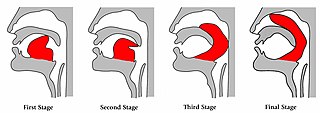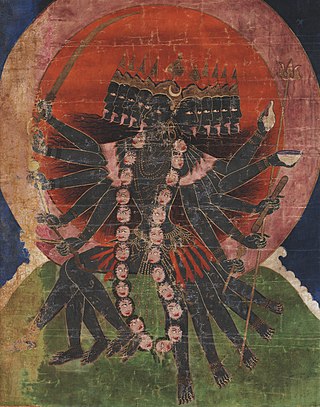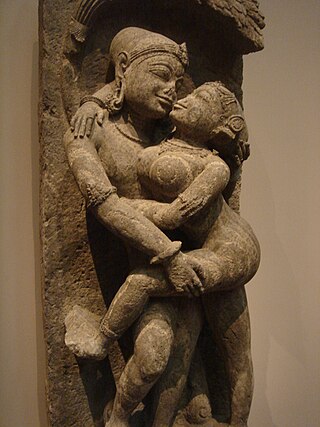
In Hinduism, kundalini is a form of divine feminine energy believed to be located at the base of the spine, in the muladhara. It is an important concept in Śhaiva Tantra, where it is believed to be a force or power associated with the divine feminine or the formless aspect of the Goddess. This energy in the body, when cultivated and awakened through tantric practice, is believed to lead to spiritual liberation. Kuṇḍalinī is associated with Parvati or Adi Parashakti, the supreme being in Shaktism; and with the goddesses Bhairavi and Kubjika. The term, along with practices associated with it, was adopted into Hatha yoga in the 9th century. It has since then been adopted into other forms of Hinduism as well as modern spirituality and New Age thought.

Shaivism is one of the major Hindu traditions, which worships Shiva as the Supreme Being. One of the largest Hindu denominations, it incorporates many sub-traditions ranging from devotional dualistic theism such as Shaiva Siddhanta to yoga-orientated monistic non-theism such as Kashmiri Shaivism. It considers both the Vedas and the Agama texts as important sources of theology. According to a 2010 estimate by Johnson and Grim, Shaivism is the second-largest Hindu sect, constituting about 253 million or 26.6% of Hindus.
Tantras in Hinduism are esoteric scriptures.

Bhairava, or Kala Bhairava, is a Shaivite and Vajrayāna deity worshipped by Hindus and Buddhists. In Shaivism, he is a powerful manifestation, or avatar, of Shiva, associated with annihilation. In the tradition of Kashmir Shaivism, Bhairava represents the Supreme Reality, synonymous to Para Brahman. Generally in Hinduism, Bhairava is also called Dandapani, as he holds a rod or danda to punish sinners, and Svaśva, meaning, "he whose vehicle is a dog". In Vajrayana Buddhism, he is considered a fierce emanation of boddhisatva Mañjuśrī, and also called Heruka, Vajrabhairava, and Yamantaka.

Abhinavagupta was a philosopher, mystic and aesthetician from Kashmir. He was also considered an influential musician, poet, dramatist, exegete, theologian, and logician – a polymathic personality who exercised strong influences on Indian culture.

Swami Lakshman Joo, born Lakshman Raina and also called Lal Sahib by his followers, was a mystic and scholar of Kashmir Shaivism.
Somananda was one of the teachers of Kashmir Shaivism, in the lineage of Trayambaka, author of the first philosophical treatise of this school, Śivadṛṣṭi. A contemporary of Bhaṭṭa Kallaṭa, the two formed the first wave of Kashmiri Shaivites to propose in a rigorous and logical way the concepts of nondual Shaivism. Somananda lived in Kashmir, most probably in Srinagar, where most of the later philosophers of the school lived, as a householder.

The Kashmir Shaivism tradition, also called Trika Shaivism, is a non-dualist branch of Shaiva-Shakta Tantra Hinduism that originated in Kashmir after 850 CE. In its place of origin in Kashmir, this tradition is commonly referred to as "Kashmiri Shaivism." It later spread beyond Kashmir, with its great scholar Abhinavagupta calling it "Trika". It particularly flourished in the states of Odisha and Maharashtra. Defining features of the Trika tradition are its idealistic and monistic Pratyabhijna ("Recognition") philosophical system, propounded by Utpaladeva and Abhinavagupta, and the centrality of the three goddesses Parā, Parāparā, and Aparā.
Shaktipata or Shaktipat refers in Hinduism to the transmission of spiritual energy upon one person by another or directly from the deity. Shaktipata can be transmitted with a sacred word or mantra, or by a look, thought or touch – the last usually to the ajna chakra or agya chakra or third eye of the recipient.

Nath, also called Natha, are a Shaiva sub-tradition within Hinduism in India and Nepal. A medieval movement, it combined ideas from Buddhism, Shaivism and Yoga traditions of the Indian subcontinent. The Naths have been a confederation of devotees who consider Shiva as their first lord or guru, with varying lists of additional gurus. Of these, the 9th or 10th century Matsyendranatha and the ideas and organization mainly developed by Gorakhnath are particularly important. Gorakhnath is considered the originator of the Nath Panth.

Khecarī mudrā is a hatha yoga practice carried out by curling the tip of the tongue back into the mouth until it reaches above the soft palate and into the nasal cavity. The tongue is made long enough to do this with many months of daily tongue stretching and, in some versions of the practice, by gradually severing the frenulum of the tongue with a sharp implement over a period of months.
Svātantrya is the Kashmiri Shaivite concept of divine sovereignty. Svātantrya is described as an energy that emanates from the Supreme (Paramaśiva), a wave of motion inside consciousness (spanda) that acts as the fundament of the world, or in another view, the original word. It does not use any external instrument as it itself is the first stage of creation.

Mahakali is the Hindu goddess of time and death in the goddess-centric tradition of Shaktism. She is also known as the supreme being in various Tantras and Puranas.

Maithuna is a Sanskrit term for sexual intercourse within Tantra, or alternatively for the sexual fluids generated or the couple participating in the ritual. It is the most important of the Panchamakara and constitutes the main part of the grand ritual of Tantra also known as Tattva Chakra. Maithuna means the union of opposing forces, underlining the nonduality between human and divine, as well as worldly enjoyment (kama) and spiritual liberation (moksha). Maithuna is a popular icon in ancient Hindu art, portrayed as a couple engaged in physical loving.
Tantrāloka is a treatise of Abhinavagupta, a writer and philosopher of the Kashmir Shaivism school of Hindu philosophy.
Prakāśa is a concept in Indian philosophy translated by various authors as "light", "luminosity", "shining forth", "manifestation", "splendour", "light of consciousness" and so forth.
The Agamas are a collection of several Tantric literature and scriptures of Hindu schools. The term literally means tradition or "that which has come down", and the Agama texts describe cosmology, epistemology, philosophical doctrines, precepts on meditation and practices, four kinds of yoga, mantras, temple construction, deity worship and ways to attain sixfold desires. These canonical texts are in Tamil and Sanskrit.

The Vijñāna-bhairava-tantra is a Shiva Tantra, of the Kaula Trika tradition of Kashmir Shaivism, possibly authored by Guru Keyūravatī. Singh notes that it is difficult to establish an exact date for the text, and it could have been written at some time from the 7th to the 8th century CE. It is also called the Śiva-jñāna-upaniṣad by Abhinavagupta.

Pratyabhijñā or Pratyabhigyā is an idealistic, monistic, and theistic school of philosophy in Kashmir Shaivism which originated in the ninth century CE. The term Trika was used by Abhinavagupta to represent the whole of Kashmir Shaivism, or to designate the Pratyabhijñā system.
Mark S. G. Dyczkowski is an English Indologist, musician, and scholar of Tantra and Kashmir Shaivism. He has published multiple translations and commentaries, most notably the 12-volume Manthanabhairava Tantra and an 11-volume Tantrāloka including the commentary by Jayaratha. Dyczkowski also plays the sitar and has collected over 1,500 compositions for sitar.











